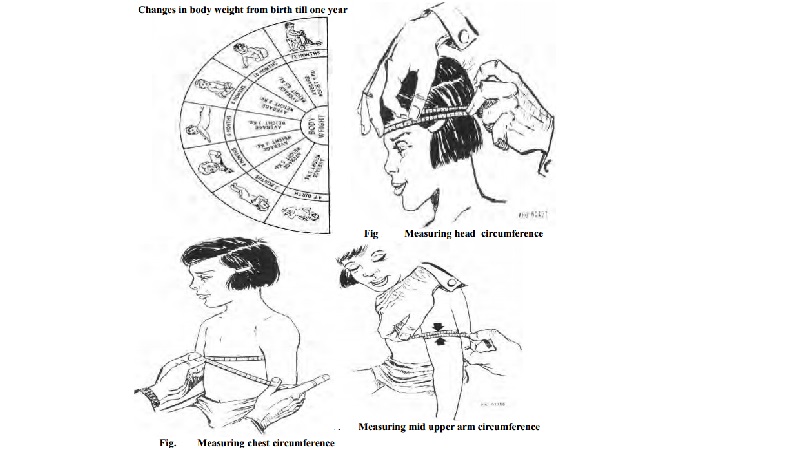Chapter: 11th 12th std standard Class Nursing Health Care Hospital Hygiene Higher secondary school College Notes
Anthropometric Measurements And Indices

ANTHROPOMETRIC MEASUREMENTS AND INDICES
Nutritional
Anthropometry is concerned with the measurements of the variations of physical
dimensions and body composition at stages of life cycle and different planes of
nutrition. It is a field-oriented method, which can be easily adopted and
interpreted.
The basic measurements which should be made on all age
groups are weight in kg, length / height and arm circumference in cms. In young
children it should be supplemented by measurements of head and chest circumference.
Weight:
Weight gain is an indicator of growth in children. It is
measured with the help of the weighing scale. Body weight should be determined
after the first void and before ingestion of food.
The
weight for age can be compared with the standards of ICMR and the nutritional
status can be interpreted.
Anthropometric Indices : Weight for
age The Nutritional status can be interpreted using Gomez Classification as follows Weight > 90% Weight for age.
Normal.
76
- 90% Weight for age. Grade I malnutrition.
61 < 75% Weight for age.
Grade II malnutrition. < 60% Weight for age. Grade III malnutrition.
Linear
Measurements
Two types of linear measurements are commonly used.
(i)
height or length of the whole body
(ii)
circumference of the head and the
chest.
Height :
The height of
the individual is
the sum of
four
components:
leg, pelvis, spine and skull.
The height of an individual is measured using a stadiometer.
For infants and children recumbent length (crown - heel
length) is measured. The measurement is compared with the standards of the ICMR
as given in table 16C to assess nutritional status.
The
desirable birth weight and length of an infant is 3 kg and 50 cm respectively.
By the time the baby turns the first birth day, the birth weight is doubled and
an increment of 25 cm in length is reached.
Head Circumference :
The
measurement of head circumference is a standard procedure to detect
pathological condition in children. Head circumference is related mainly to
brain size. At birth the circumference of head is greater than that of the
chest.
Chest Circumference :
The circumference of the head and the chest are about the
same at six months of age. After this the skull grows slowly and the chest more
rapidly.
Therefore between the ages of six months and five years the
chest / head circumference ratio of less than one may be due to failure to
develop or due to wasting of muscle and fat of chest.
In
nutritional anthropomertry the chest / head circumference ratio is of value in
detecting under nutrition in early childhood.
Mid Upper Arm Circumference (MUAC) :
Mid upper arm circumference at birth in a healthy child is
between 10 - 11cm. over the first year the increment in MUAC is 3 to 4 cm as
the muscles of the arms start to develop. In the preschool age the increase in
MUAC is only one cm. Hence there is not much difference between the MUAC of a 3
year old from that of a 5 year old. So MUAC is an age independent index. The
field workers in nutrition in our country have fixed the desirable value for
MUAC as 12 cm for Indian preschool children.
The WHO has recommended 14
centimeter as a desirable value for MUAC for preschool children.
Hence
in screening malnourished children in a community this method is used with
ease. When the value of MUAC is less
than 12 cm among 1 -5 year old children, they are designated as malnourished.
In
the field condition a bangle with a diameter of 4 centimeter can be used as a
tool to detect malnutrition. When the bangle moves smoothly over the mid-upper
arm of the child, it indicates malnutrition. The bangle test can be conducted
with ease in field condition to screen malnourished children.
Related Topics